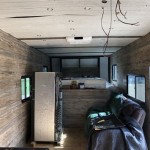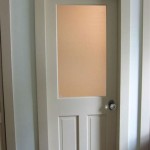What Are Mobile Home Interior Walls Made Of?
Understanding the construction of mobile home interior walls is crucial for homeowners considering renovations, repairs, or simply seeking to improve their living spaces. Unlike traditional stick-built homes, mobile homes utilize different materials and construction techniques to achieve affordability and portability. This article delves into the various materials used in mobile home interior walls, their properties, and the implications for maintenance and remodeling.
The construction of mobile home walls is governed by the HUD (Housing and Urban Development) code, which sets standards for safety, durability, and energy efficiency. While manufacturers have some flexibility in choosing materials, they must adhere to these stringent regulations. The specific materials used often depend on the age of the mobile home and the manufacturer's preferences.
Common Materials Used in Mobile Home Interior Walls
Several materials are typically found in mobile home interior walls. These materials are chosen for their cost-effectiveness, lightweight nature, and ability to meet the HUD code requirements.
Paneling: Perhaps the most recognizable feature of mobile home interiors is the use of paneling. This is a thin sheet material applied over the wall studs. Traditionally, this paneling was often made of luan plywood with a vinyl or paper covering to simulate wood grain or other textures. Luan plywood is a type of tropical hardwood plywood known for its smooth surface and relatively low cost. However, it is also susceptible to moisture damage and can delaminate over time. Newer mobile homes may utilize enhanced paneling options with improved moisture resistance and durability, but the basic principle of a thin, pre-finished sheet applied to the studs remains largely the same.
The paneling is typically attached to the wall studs using staples, nails, or adhesive. The seams between the panels are often covered with batten strips, which are thin pieces of wood or vinyl that conceal the joints and provide a more finished appearance. These strips can sometimes become loose or detached over time, requiring repair or replacement.
The thinness of the paneling is a defining characteristic. It is significantly thinner than the drywall used in conventional homes, which contributes to its lower cost and lighter weight. However, it also means that it offers less sound insulation and is more prone to damage from impacts.
Drywall: While paneling is the most common, some mobile home manufacturers do use drywall, particularly in more recent models or higher-end units. Drywall, also known as gypsum board, is a thicker and more durable material than paneling. It provides better sound insulation and a smoother, more paintable surface. The use of drywall can significantly enhance the appearance and feel of a mobile home interior, making it more closely resemble a traditional house.
However, installing drywall in a mobile home requires a more robust wall structure to support its weight. The wall studs may need to be spaced closer together, and the framing must be properly secured to prevent cracking during transport. The joints between the drywall sheets are taped and mudded to create a seamless surface, which is then sanded and painted.
Drywall is generally considered a superior choice for interior walls compared to paneling due to its durability, sound insulation, and aesthetic qualities. However, it also comes at a higher cost and requires more labor to install.
Wallpaper/Vinyl Covering: Some mobile homes may have wallpaper or vinyl coverings applied directly to the interior wall surfaces. These coverings can add visual interest and texture to the walls, and they may also provide some degree of moisture resistance. However, they can be difficult to remove if you decide to redecorate, and they may also trap moisture underneath, leading to mold or mildew growth.
Wallpaper or vinyl coverings are typically applied over a base layer of paneling or drywall. The surface must be properly prepared to ensure that the covering adheres properly. This may involve sanding, priming, or applying a special adhesive.
Insulation: Insulation is a critical component of mobile home walls, as it helps to regulate temperature and reduce energy costs. The type and amount of insulation used can vary depending on the climate and the manufacturer's specifications. Common types of insulation used in mobile home walls include fiberglass batts, rigid foam boards, and spray foam.
Fiberglass batts are the most common and cost-effective type of insulation. They are made of spun glass fibers and are typically installed between the wall studs. Rigid foam boards provide a higher level of insulation and can be used in conjunction with fiberglass batts. Spray foam insulation creates an airtight seal and can fill even the smallest gaps and cracks. It is the most expensive option, but it provides the best thermal performance.
Proper insulation is essential for maintaining a comfortable living environment and reducing energy consumption. It can also help to prevent moisture buildup and mold growth within the walls.
Considerations for Remodeling Mobile Home Interior Walls
Remodeling mobile home interior walls presents unique challenges compared to remodeling a traditional home. The thinner walls and different construction techniques require careful planning and execution.
Weight Restrictions: One of the primary considerations is weight. Mobile homes are designed to be lightweight for transportation purposes. Adding heavy materials like drywall or tile can overload the structure and potentially cause damage. It is important to consult with a qualified contractor or engineer to determine the weight-bearing capacity of the walls before making any significant changes.
Stud Spacing: The wall studs in mobile homes are often spaced further apart than in traditional homes. This can make it difficult to attach new fixtures or cabinets to the walls. It may be necessary to add additional studs or bracing to provide adequate support. Before attaching anything to the wall, locate the studs using a stud finder.
Electrical Wiring and Plumbing: Mobile home walls often contain electrical wiring and plumbing lines. Exercise extreme caution when working on the walls to avoid damaging these systems. Turn off the power and water supply before starting any work. If you are not comfortable working with electrical or plumbing systems, hire a qualified professional.
Moisture Control: Moisture is a major enemy of mobile homes. Leaks and condensation can lead to mold growth, rot, and structural damage. It is essential to address any leaks promptly and to ensure proper ventilation throughout the home. Consider using moisture-resistant materials in areas prone to moisture, such as bathrooms and kitchens.
Paneling Repair vs. Replacement: When dealing with damaged paneling, homeowners often face the decision of whether to repair or replace it. Minor scratches and dents can often be repaired with wood filler and paint. However, if the paneling is severely damaged or delaminated, it may be necessary to replace it. Replacing a section of paneling can be challenging, as it may be difficult to match the existing color and texture. Consider replacing all the paneling in a room to ensure a uniform appearance.
Alternative Wall Covering Options: Besides drywall, other wall covering options can be considered for mobile home remodeling. Beadboard is a classic and versatile option that can add texture and character to the walls. It is also relatively lightweight and easy to install. Wainscoting is another option that involves covering the lower portion of the walls with panels or boards. This can provide a more upscale look and protect the walls from damage.
Understanding the Impact of Wall Materials on Insulation and Soundproofing
The materials used in mobile home interior walls directly impact the home's insulation and soundproofing capabilities. This has implications for energy efficiency, comfort, and overall livability.
Thermal Insulation: As previously mentioned, insulation is a critical component for thermal regulation. The R-value of the insulation material is a measure of its resistance to heat flow. Higher R-values indicate better insulation. The type and amount of insulation used in the walls will significantly impact the home's energy efficiency and heating/cooling costs. Consider upgrading the insulation during a remodel to improve energy performance.
Sound Transmission: The density and composition of the wall materials also affect sound transmission. Thicker and denser materials, such as drywall, provide better sound insulation than thinner materials like paneling. Adding soundproofing materials, such as resilient channels or sound-dampening insulation, can further reduce noise transmission between rooms.
Air Sealing: Air leaks can significantly reduce the effectiveness of insulation. Gaps and cracks around windows, doors, and wall penetrations should be sealed with caulk or weatherstripping to prevent air infiltration. Proper air sealing can improve energy efficiency and reduce drafts.
Impact of Paneling: Traditional mobile home paneling offers minimal insulation and soundproofing. Its thinness allows for easy heat transfer and sound transmission. Therefore, if improving energy efficiency and noise reduction are priorities, replacing paneling with drywall and adding insulation is highly recommended.
Impact of Drywall: Drywall provides significantly better insulation and soundproofing compared to paneling. Its density helps to block sound waves and its thickness provides a greater barrier to heat transfer. When combined with proper insulation and air sealing, drywall can significantly improve the comfort and energy efficiency of a mobile home.
By understanding the materials used in mobile home interior walls and their properties, homeowners can make informed decisions about maintenance, repairs, and remodeling projects. Careful planning and execution are essential to ensure that any modifications are safe, durable, and in compliance with applicable codes and regulations. Always prioritize safety and consult with qualified professionals when necessary.

What Types Of Walls Are In Manufactured Homes

How Thick Are Manufactured Home Walls L Clayton Studio

How Manufactured Homes Are Built L Clayton Studio

Mobile Home Construction Process Overview A Story Of Sd And Efficiency Homes Direct

Three Ways To Cover Mobile Home Walls

Mobile Home Wall Removal In 2024 Smoothing Out The Strips

File Manufactured Home Side Walls Are Built And Attached Jpg Wikimedia Commons

Maintaining Manufactured Home Walls Ceiling Clayton Studio

Three Ways To Cover Mobile Home Walls

Removing Walls In A Mobile Home Ignite Mhc
Related Posts








